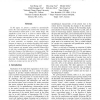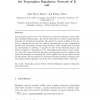BIBM
2009
IEEE
13 years 9 months ago
2009
IEEE
Abstract--Medical image segmentation has become an essential technique in clinical and research-oriented applications. Because manual segmentation methods are tedious, and fully au...
BIBE
2009
IEEE
13 years 9 months ago
2009
IEEE
In this paper, we present a method to automatically extract the vessel segments and construct the vascular tree with anatomical realism from a color retinal image. The significanc...
ASWC
2009
Springer
13 years 9 months ago
2009
Springer
Driven by the goal of automating data analyses in the field of bioinformatics, SHARE (Semantic Health and Research Environment) is a specialized SPARQL engine that resolves queries...
WABI
2010
Springer
13 years 9 months ago
2010
Springer
Abstract. A recursive algorithm by Aho, Sagiv, Szymanski, and Ullman [1] forms the basis for many modern rooted supertree methods employed in Phylogenetics. However, as observed by...
PRIB
2010
Springer
13 years 9 months ago
2010
Springer
Abstract. An important unsolved problem in structural bioinformatics is that of protein structure prediction (PSP), the reconstruction of a biologically plausible three-dimensional...
PRIB
2010
Springer
13 years 9 months ago
2010
Springer
ISBRA
2010
Springer
13 years 9 months ago
2010
Springer
The study of non-sequential alignments, with different connectivity of the aligned fragments in the proteins being compared can offer a more complete picture of the structural, evo...
BIOCOMP
2010
13 years 9 months ago
2010
The tryptophan operon of E. coli represents an important regulatory unit consisting of multiple feedback loops. The role of these loops is crucial to understand the dynamics of tr...
BIOCOMP
2010
13 years 9 months ago
2010
- We present a novel hierarchical modular decision engine for lung nodule detection from CT images implemented by Artificial Neural Networks. The proposed Computer Aided Detection ...
BIOCOMP
2010
13 years 9 months ago
2010
Abstract-- Modeling the intermolecular reactions in a single cell is a critical problem in computational biology. Biochemical reaction systems often involve species in both low and...


